Indian cuisine stands as a fiery testament to the country’s love affair with bold flavors and aromatic spices. From the mountainous north to the coastal south, each region boasts signature dishes that challenge your heat tolerance while rewarding your taste buds with complex, unforgettable flavors.
These spicy creations aren’t just about setting your mouth ablaze – they’re carefully crafted symphonies where chilies dance with cardamom, cloves, cinnamon, and countless other spices. The magic happens when these ingredients transform humble meats and vegetables into dishes that have captivated food lovers for centuries.
Ready for a culinary adventure that might require a glass of milk nearby? These seventeen spicy Indian masterpieces represent the pinnacle of heat and flavor, offering a glimpse into traditions that turn dining into an exhilarating experience. Your taste buds may never be the same again!
1. Chicken Chettinad
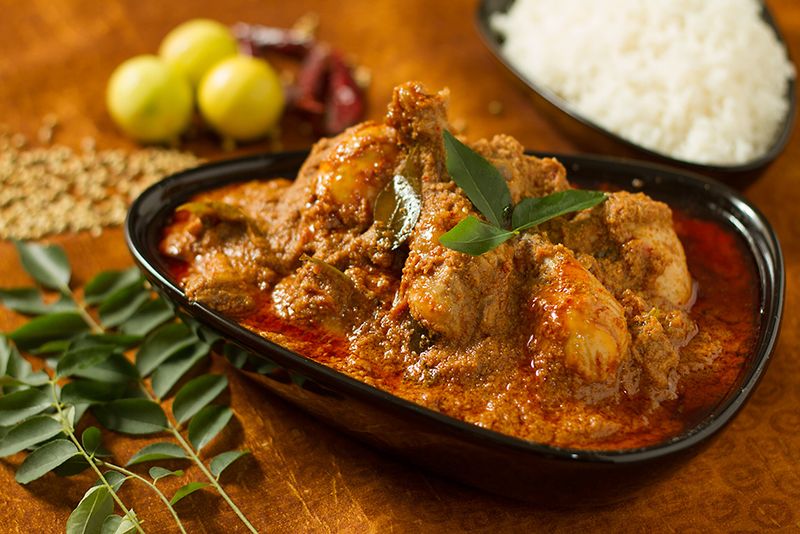
Fiery and aromatic, Chicken Chettinad emerged from the kitchens of the Chettinad region in Tamil Nadu, where spice traders once brought the finest ingredients from around the world. This legendary dish combines freshly ground spices including star anise, kalpasi (stone flower), and an abundance of black peppercorns that deliver intense heat without overwhelming the palate. The magic lies in the slow-cooking process, where marinated chicken absorbs a complex spice blend along with coconut, creating layers of flavor that unfold with each bite. Traditional preparation involves dry roasting and grinding nearly two dozen spices, though modern recipes have simplified this somewhat.
2. Laal Maas

Hunting parties of Rajasthani royalty created Laal Maas centuries ago, needing a dish that could be preserved in the desert heat while delivering enough spice to mask any gamey flavors. The name literally translates to “red meat” – a fitting description for this vibrant curry that gets its signature color from dried mathania chilies, cultivated exclusively in Rajasthan’s Jodhpur region. Tender chunks of lamb simmer slowly in a gravy thickened with yogurt and enriched with ghee, allowing the meat to absorb the intense spice blend. The authentic version uses no tomatoes – the brilliant red comes purely from chilies, with garlic, onions and a touch of kachri (wild melon) providing depth. Traditionally served at royal feasts, this dish embodies Rajasthan’s warrior spirit with its unapologetic heat. The first bite might shock your system, but the complex flavors that follow make the initial fire worth braving.
3. Kolhapuri Chicken
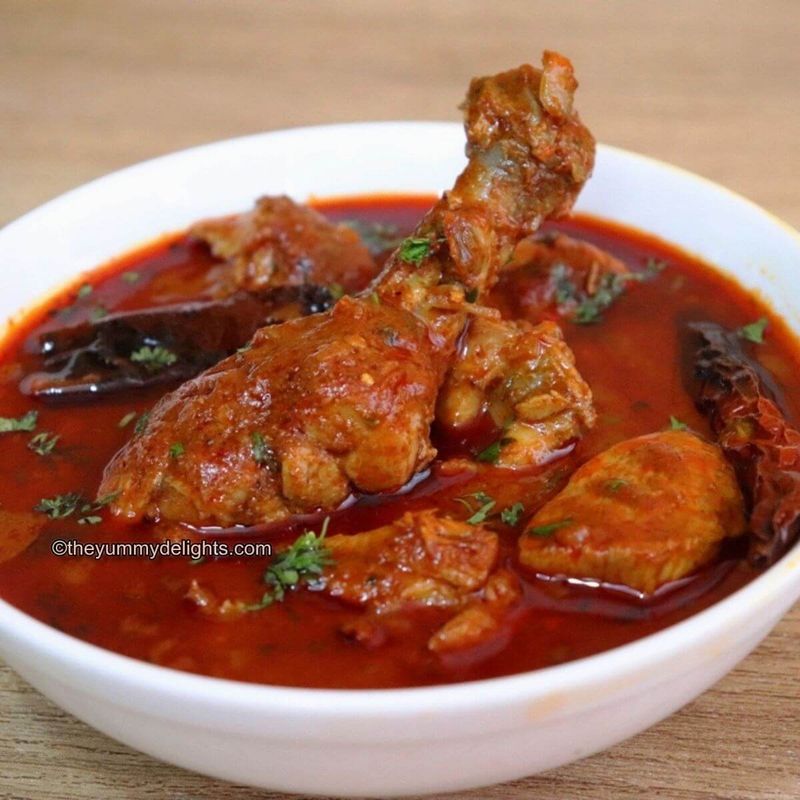
Born in Maharashtra’s spice capital, Kolhapuri Chicken showcases the region’s mastery of heat through its signature spice blend – the famous Kolhapuri masala. Cooks dry-roast and hand-pound coriander seeds, cloves, cinnamon, black peppercorns, and fiery red chilies, creating a smoky base that defines this iconic dish. Unlike many Indian curries, Kolhapuri preparation involves minimal water, resulting in an intensely concentrated gravy that clings to each piece of chicken. The distinctive taste comes from two special ingredients: dagadphool (stone flower lichen) and kala masala, a regional spice mix that undergoes a unique charring process. Local legend claims true Kolhapuri chicken should make tears stream down your face – but culinary masters know the dish isn’t about pure pain. Rather, it’s the addictive combination of heat, smokiness, and complex spices that keeps devotees coming back despite the sweat beading on their foreheads.
4. Vindaloo (Pork or Chicken)
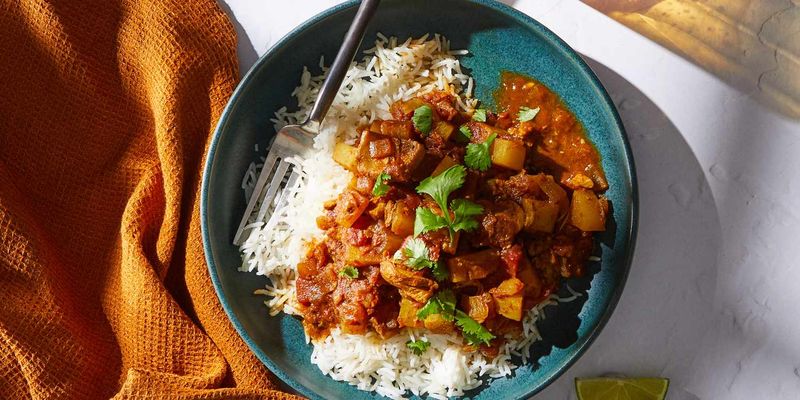
Colonial history simmers in every spoonful of Vindaloo, a dish born when Portuguese sailors introduced wine vinegar preservation techniques to Goa’s shores. The name itself reveals its origins – “vin” (vinegar) and “alho” (garlic) transformed over centuries into a curry that would become internationally famous for its fiery reputation. Authentic Vindaloo marinates meat (traditionally pork) in vinegar, garlic, and kashmiri chilies before slow-cooking with a precise blend of spices including cinnamon, cloves, and cumin. The vinegar performs double duty – preserving the meat in pre-refrigeration days while creating the signature tangy-spicy flavor profile that distinguishes it from other Indian curries. Contrary to British curry house versions that often prioritize pure heat, traditional Goan Vindaloo balances its considerable spice with complex sour notes and a depth that comes from careful layering of flavors. The result: a dish that burns gloriously but never loses its character beneath the heat.
5. Andhra Chicken Fry
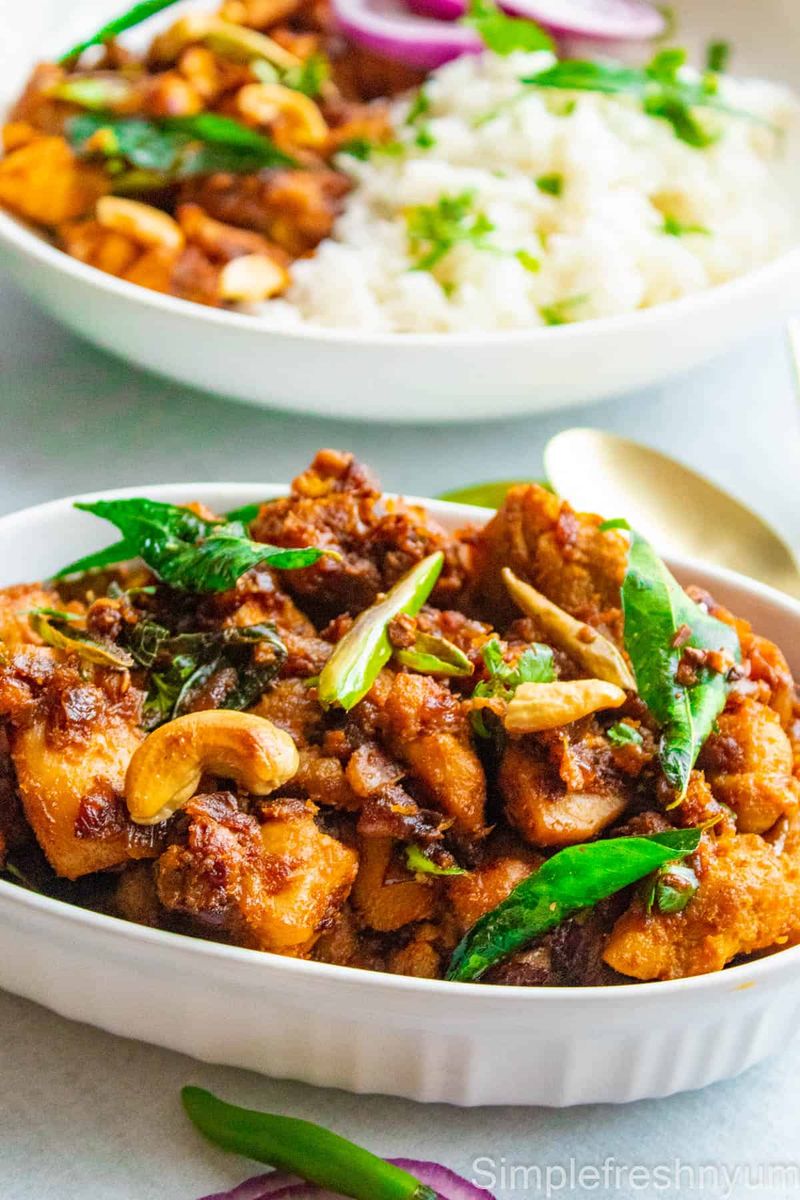
Guntur chilies reign supreme in Andhra Pradesh, a state renowned throughout India for producing dishes that challenge even the most seasoned spice enthusiasts. Andhra Chicken Fry exemplifies this heat-loving tradition, featuring chicken pieces marinated in yogurt, ginger-garlic paste, and a liberal coating of fiery red chili powder before being dry-fried to crispy perfection. Unlike many Indian dishes where spices mellow during cooking, this preparation intentionally concentrates the heat through reduction, creating an intensely flavored dish where each piece of chicken delivers a powerful punch. The distinctive preparation involves a two-stage cooking process – first simmering to tenderize, then frying until moisture evaporates, leaving only concentrated flavor behind. Local cooks add their signature through tempering with curry leaves, mustard seeds, and sometimes a splash of toddy (palm wine) for extra tanginess. Served as a side dish rather than a main curry, even small portions provide a thrilling challenge to your spice tolerance.
6. Mirchi Ka Salan
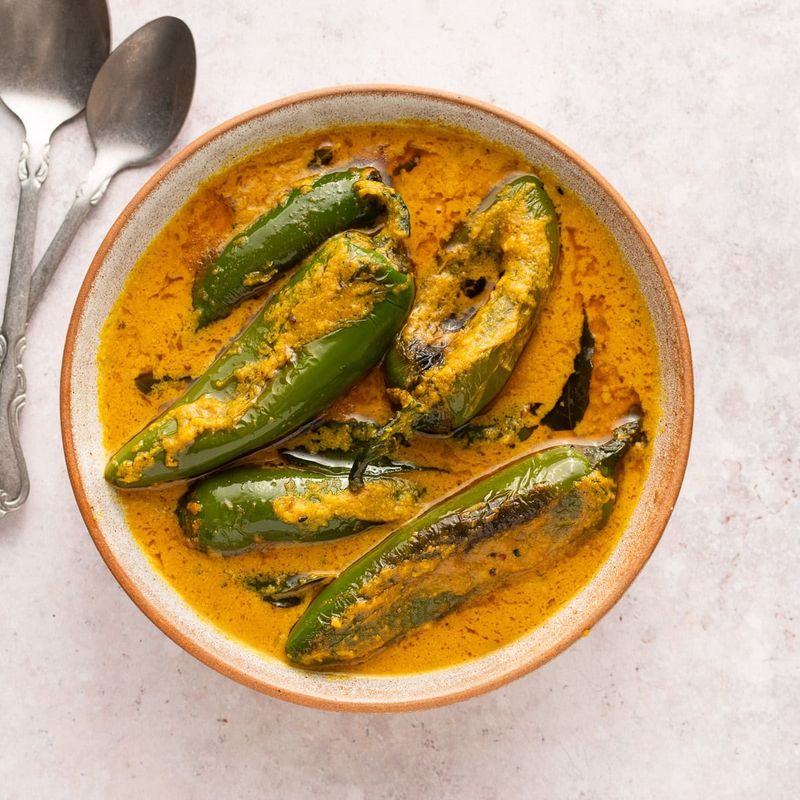
Hyderabadi royalty developed Mirchi Ka Salan as the perfect accompaniment to their famous biryani, creating a dish where chilies aren’t just a seasoning – they’re the star ingredient. Whole green chilies simmer in a rich, nutty gravy thickened with peanuts, sesame seeds, and coconut, creating a fascinating paradox where chilies both provide and temper the heat. The genius of this Nizami creation lies in its counterintuitive approach – the gravy’s creamy, slightly sweet nature softens the chilies’ burn while amplifying their flavor. Traditional preparation involves hand-grinding the paste on stone grinders, releasing essential oils from the nuts that commercial blenders can’t quite replicate. Regional variations exist across Telangana and parts of Maharashtra, but authentic versions always include tamarind for sourness and a pinch of sugar to balance the heat. When prepared by skilled hands, this dish achieves the remarkable feat of being simultaneously fiery and soothing – a culinary contradiction that explains its enduring appeal.
7. Bhut Jolokia Chutney
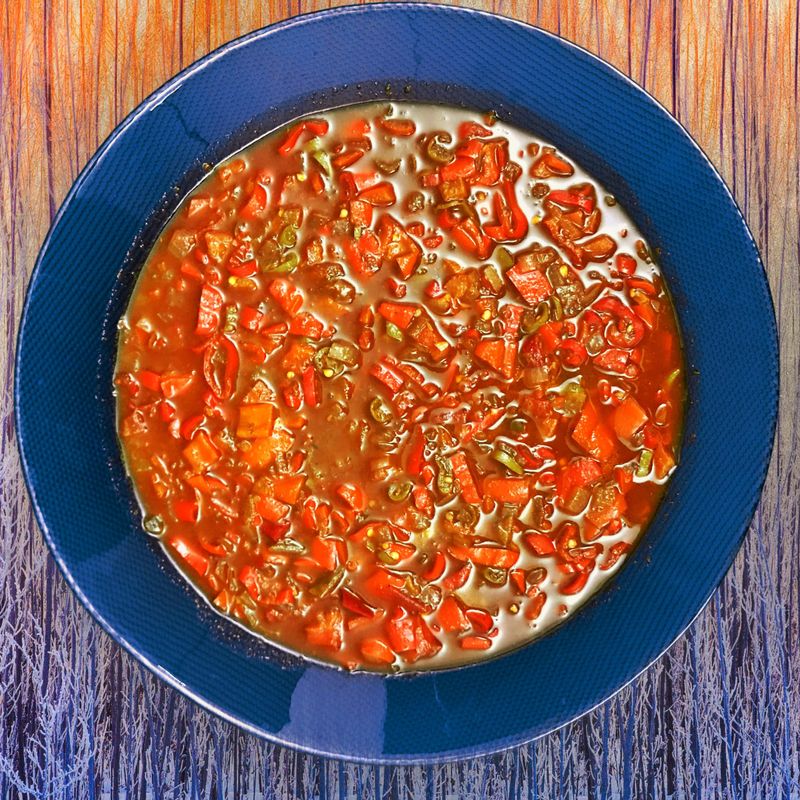
Northeast India’s tribal communities harness the legendary ghost pepper in this deceptively simple chutney that once held the Guinness World Record for containing the hottest natural chili on earth. Assamese and Naga cooks crush fresh bhut jolokia (measuring over one million Scoville heat units) with garlic, ginger, and sometimes fermented fish to create a condiment that demands both courage and respect. Unlike commercial hot sauces that often sacrifice flavor for heat, this traditional preparation balances the pepper’s fruity undertones with salt and a splash of citrus. The result delivers an initial sweetness that momentarily fools your taste buds before unleashing an intense burning sensation that can last for over 30 minutes. In its homeland, this chutney isn’t just a condiment but medicine – locals believe it fights intestinal parasites, improves circulation, and induces a euphoric state through endorphin release. Visitors to the region are advised to start with a drop the size of a grain of rice and work up gradually.
8. Madras Curry
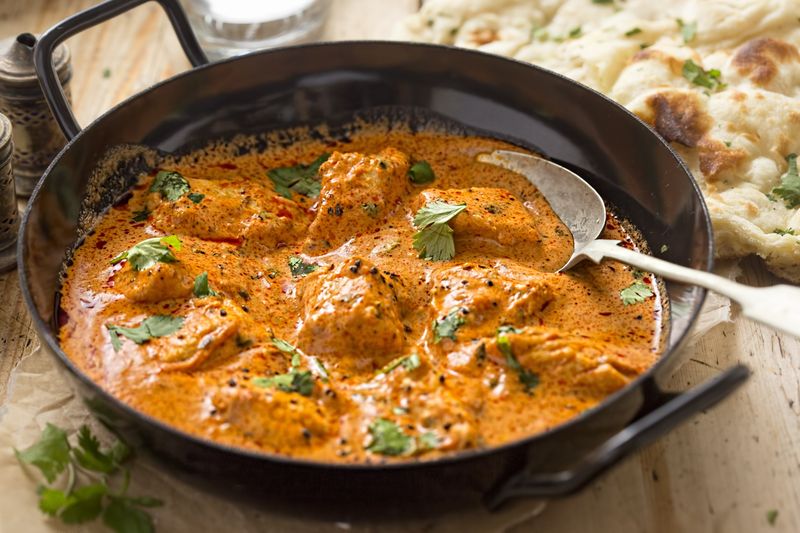
Colonial-era British traders first encountered this fiery Tamil preparation in Chennai (formerly Madras), forever linking the city’s name with heat in Western culinary consciousness. Though not technically a specific traditional dish in India, authentic Madras curry features a distinctive blend of toasted spices dominated by red chilies, coriander, fenugreek, and curry leaves, creating its characteristic deep crimson color. The preparation begins with whole spices bloomed in oil, releasing essential oils before ground spices join the mix, preventing the bitterness that comes from burning powdered spices. Unlike northern Indian curries, Madras typically incorporates coconut in some form – either as milk, grated flesh, or oil – lending a subtle sweetness that complements the considerable heat. Southern Indian cooks might not recognize the name “Madras curry,” but they would immediately identify the flavor profile that has become an international ambassador for the region’s fiery culinary traditions. The dish perfectly showcases how Indian cuisine balances extreme heat with complex flavor.
9. Spicy Paneer Tikka

Vegetarians needn’t miss out on India’s spice adventures thanks to this north Indian creation that transforms humble cheese into a fiery delight. Cubes of fresh paneer (Indian cottage cheese) marinate in a blend of yogurt, ginger, garlic, and a generous dose of red chili powder before meeting intense heat in a tandoor oven, creating a dish with a deceptively innocent appearance. The genius lies in paneer’s unique properties – its mild flavor absorbs spices beautifully while its firm texture stands up to high-temperature cooking without melting. Traditional recipes include kasuri methi (dried fenugreek leaves) and mustard oil, ingredients that add distinctive smoky undertones that complement the heat. Street vendors across Delhi and Punjab serve this dish straight from skewers, often with sliced onions and a squeeze of lime to cut through the richness. The contrast between the charred, spicy exterior and the cool, creamy interior creates a textural experience that explains why this dish has become a global ambassador for Indian vegetarian cuisine.
10. Chicken 65
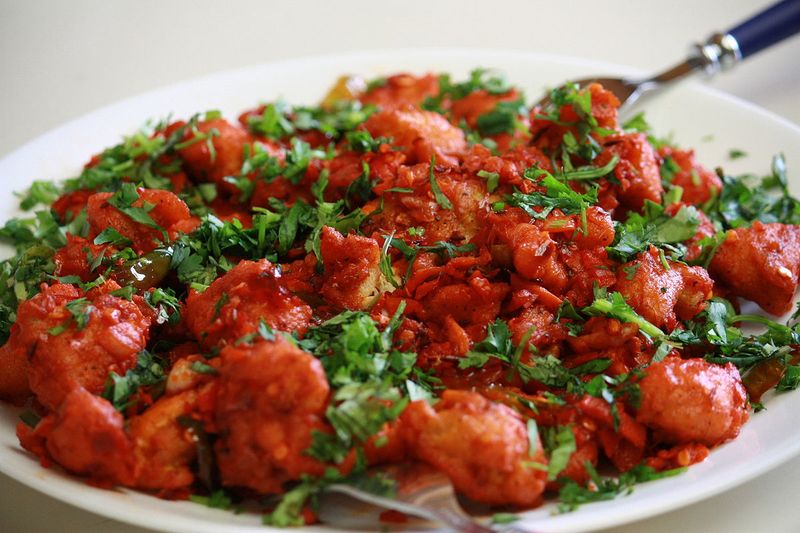
Mystery surrounds the origins of this bright red, fiercely spicy fried chicken – was it invented in 1965? Does it contain 65 chilies? Perhaps it was the 65th item on a restaurant menu? While Chennai’s Buhari Hotel claims credit for its creation, the name’s true origin remains contentious even as its popularity has spread throughout India and beyond. The distinctive preparation involves marinating chicken pieces in yogurt, ginger, garlic, and a potent blend of spices before deep-frying to crispy perfection. What separates it from other fried chicken dishes is the final step – tossing the fried pieces in a sizzling tempering of curry leaves, green chilies, and sometimes a splash of vinegar that creates its characteristic tang. Modern variations include Chicken 65 Biryani and fusion versions with Chinese influences, but purists insist the original stands alone with its perfect balance of crunch, heat, and acidity. A popular bar snack across South India, it pairs perfectly with cold beer – a combination that helps tame its considerable fire.
11. Phaal Curry
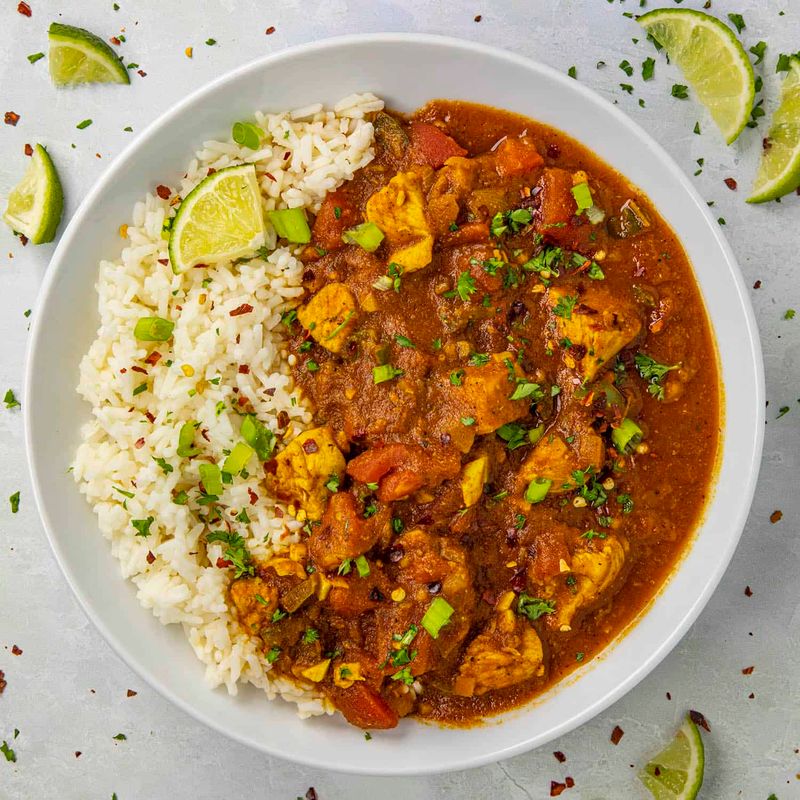
Competitive eating meets culinary tradition in Phaal curry, a British-Indian creation that ranks among the world’s hottest dishes. Developed in UK curry houses for customers seeking extreme heat challenges, authentic Phaal incorporates multiple chili varieties including scotch bonnets, habaneros, and sometimes even pure capsaicin extract to achieve its fearsome reputation. Unlike traditional Indian dishes that balance heat with complex flavor profiles, Phaal makes no apologies for prioritizing pure, face-melting spiciness. The preparation typically includes a base of onions, ginger, and garlic, but these milder ingredients merely provide a canvas for the astronomical chili content that defines the dish. Many restaurants require customers to sign waivers before ordering, and some award certificates to those who finish a full portion. Though purists might dismiss it as a novelty rather than authentic cuisine, Phaal represents an interesting cultural exchange – British curry houses creating an Indian-inspired dish that’s now made its way back to India as a tourist attraction for heat-seeking culinary daredevils.
12. Spicy Egg Masala
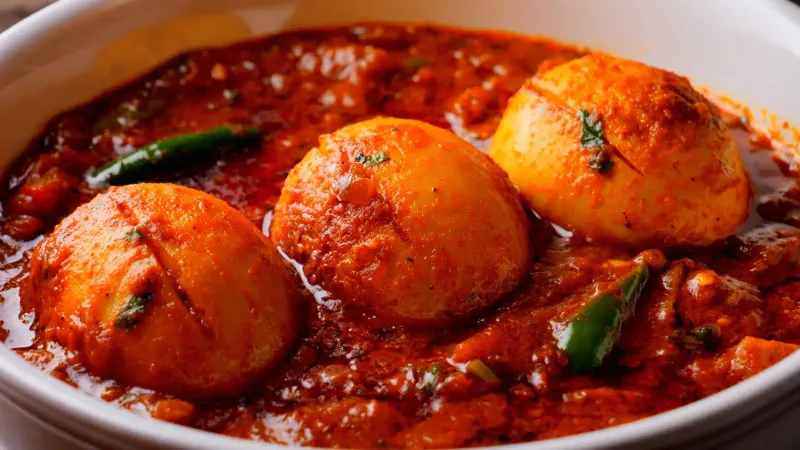
Humble ingredients transform into something extraordinary in this everyday dish found in homes and roadside dhabas throughout India. Hard-boiled eggs simmer in a gravy perfumed with caramelized onions, ginger, garlic, and a generous dose of red chili powder, creating comfort food with a serious kick. Regional variations abound – Kerala versions incorporate coconut milk, while Punjab’s interpretation features a drier, more intensely spiced gravy. What remains consistent is the clever technique of making small incisions in the eggs after boiling, allowing the spicy gravy to penetrate and flavor the otherwise mild whites and yolks. This dish perfectly illustrates how Indian cuisine elevates simple proteins through spice mastery. Budget-friendly yet satisfying, it’s often prepared when unexpected guests arrive or when the household budget needs stretching. Despite its humble status, a well-made egg masala delivers complex flavors that belie its simple ingredients – proving that fiery Indian cuisine doesn’t require expensive components to create memorable meals.
13. Dry Chili Gobi (Cauliflower)
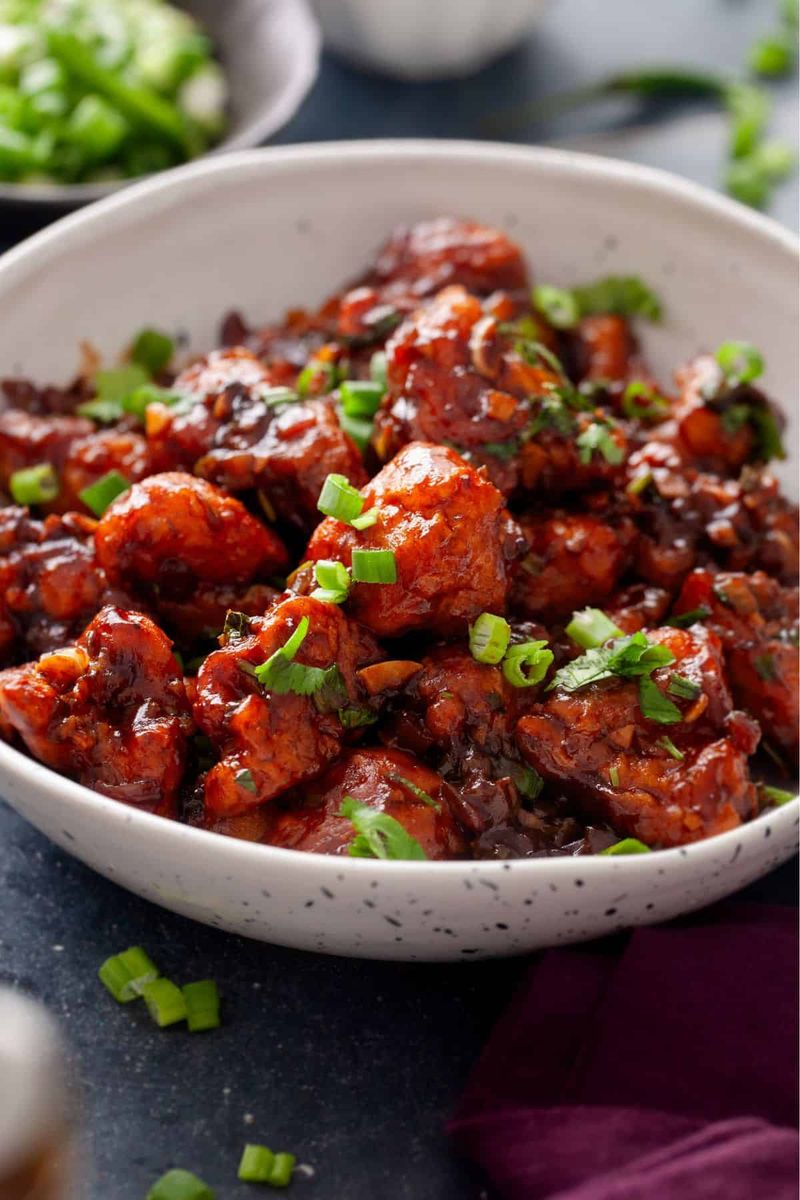
Cultural fusion sizzles in this Indo-Chinese creation that transforms humble cauliflower into an addictively spicy street food favorite. Crispy, batter-fried cauliflower florets tossed in a sauce featuring soy sauce, vinegar, and an abundance of red chilies create a dish that’s simultaneously crispy, tangy, and fiercely hot. The preparation technique involves double-frying for maximum crispness – first at a lower temperature to cook the cauliflower through, then at high heat to create the shattering crust that stands up to the sauce. What makes this dish distinctive is the finishing touch: a smoky tempering of dried red chilies, Sichuan peppercorns, and sometimes star anise that adds aromatic complexity to the heat. Originally created by Chinese immigrants in Kolkata, this dish exemplifies how culinary traditions evolve across borders. Today, you’ll find it in every Indo-Chinese restaurant and street food stall across India, often served with a sprinkle of white sesame seeds and spring onions that provide visual contrast to its deep red coating.
14. Green Chili Pickle (Hari Mirch Ka Achaar)
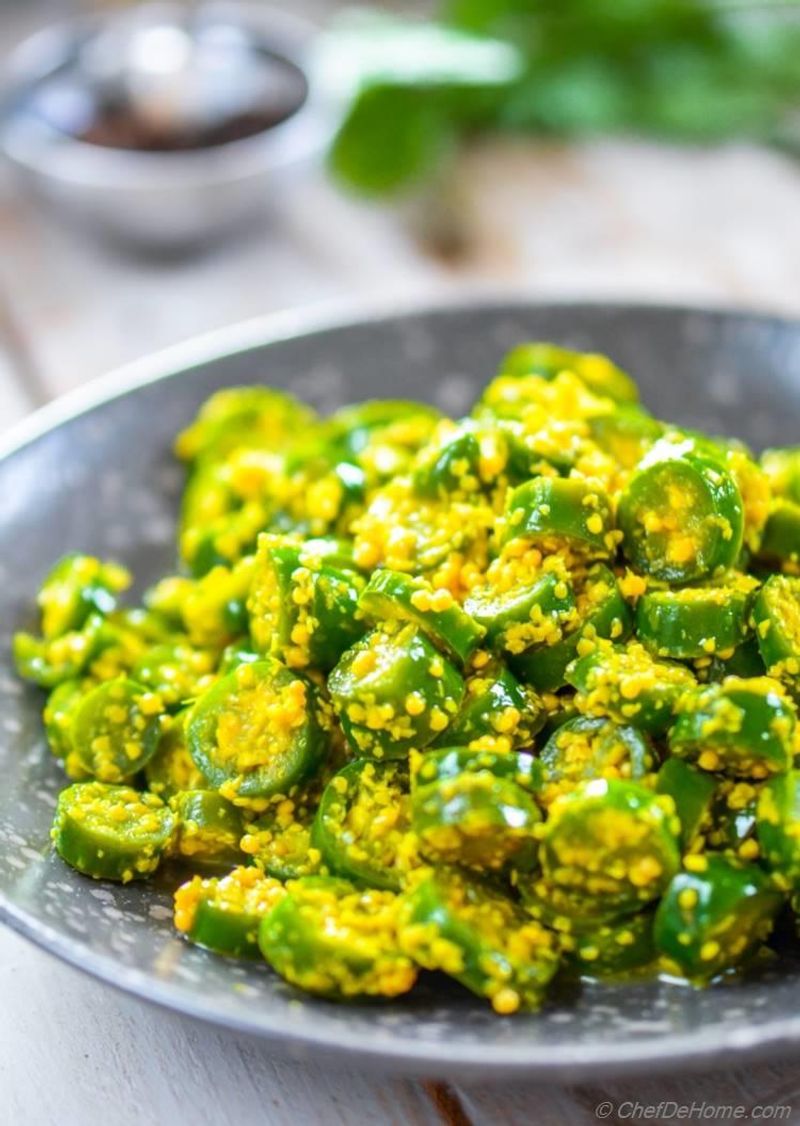
Preservation techniques meet heat addiction in this traditional condiment that transforms simple green chilies into a fiery accompaniment that can elevate even the plainest meal. Whole chilies ferment in mustard oil with fenugreek seeds, fennel, and asafoetida, creating a pickle that delivers both immediate heat and complex, developed flavors that intensify over months of aging. The preparation begins with a crucial step – sun-drying the chilies briefly to remove excess moisture without fully desiccating them. This traditional technique prevents spoilage while concentrating flavor. Regional variations exist across India – Punjabi versions include onion seeds, while Rajasthani recipes might incorporate mango powder for tanginess. Beyond its role as a condiment, this pickle serves practical purposes in traditional Indian households – a small portion eaten before traveling supposedly prevents motion sickness, while its high oil content and capsaicin are believed to have preservative properties for both the pickle and the digestive system. Just a small dab alongside rice or bread transforms a simple meal into a flavor adventure.
15. Spicy Masala Dosa with Gunpowder (Milagai Podi)
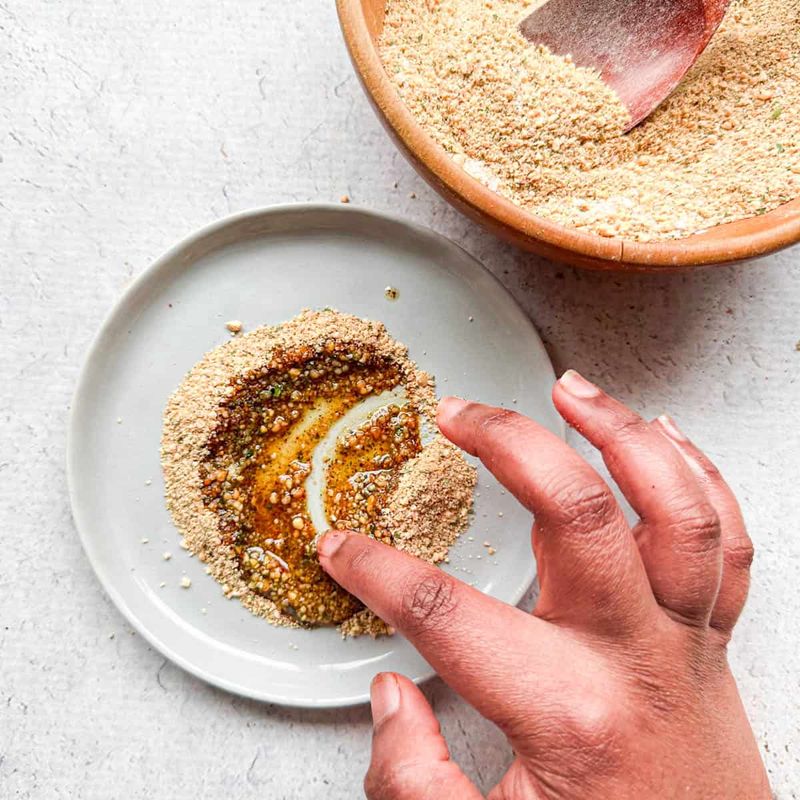
South Indian breakfast transforms into a fiery feast when crispy fermented rice crepes meet potent spice blends. The magic happens when a perfectly cooked dosa – paper-thin, golden and crisp on one side, slightly chewy on the other – gets slathered with ghee and a generous sprinkle of milagai podi (literally “chili powder”), a blend that can contain up to a dozen different ingredients. Traditional gunpowder mix combines roasted lentils, sesame seeds, and an alarming quantity of dried chilies, ground to varying textures for a complex mouthfeel. The heat builds progressively – first comes the nutty richness of the ghee, then the toasty lentil flavors, followed by a mounting wave of spice that can bring tears to unprepared eyes.
16. Jodhpuri Mirchi Vada
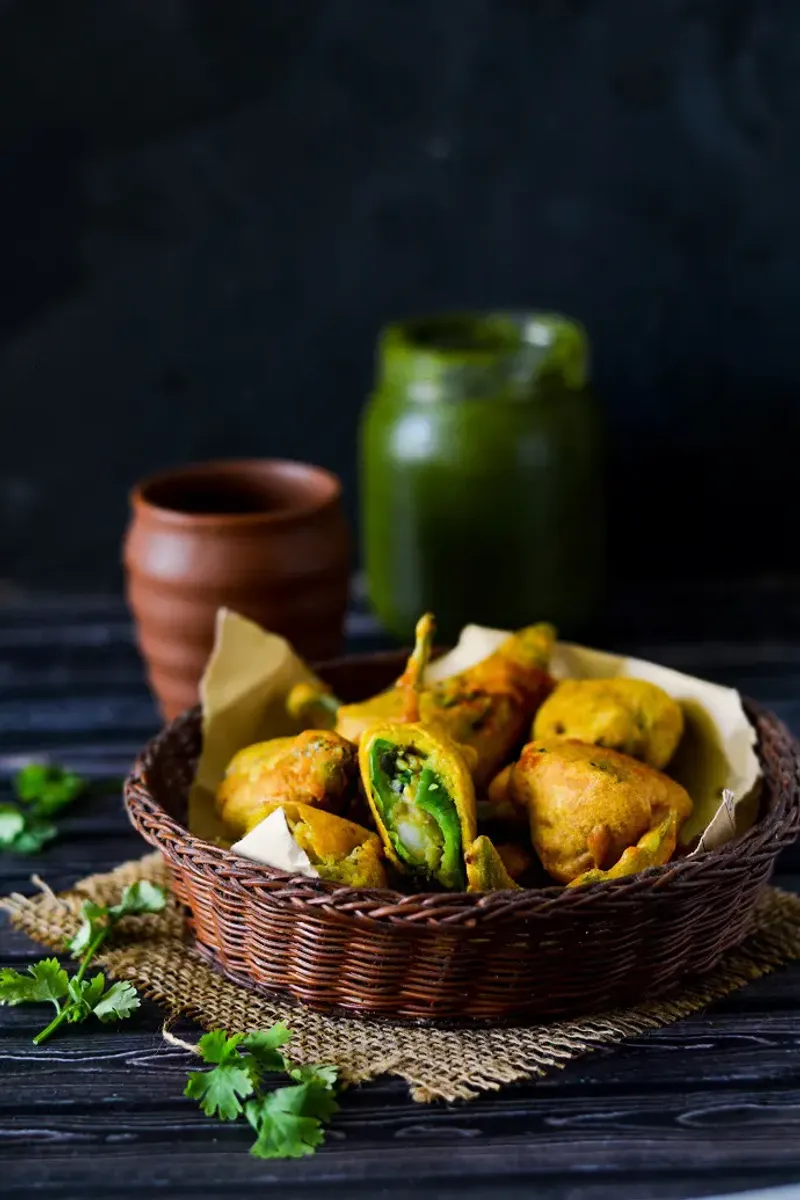
Rajasthan’s desert climate bred heat-loving palates, perfectly exemplified by this beloved street food that turns chilies into vessels for spicy potato filling. Large green chilies (typically Bhavnagri or Anaheim varieties) undergo careful preparation – deseeded through a small slit, then stuffed with a mixture of potatoes, onions, and a blend of spices including cumin, coriander, and amchur (dried mango powder). The genius lies in the contrast – a gram flour batter coating creates a protective layer between the chili’s heat and your lips, while allowing the flavors to meld during deep-frying. Experienced vendors know precisely when to harvest the chilies – young enough to remain tender when fried, but mature enough to deliver the signature heat that locals expect. Served with both sweet-tangy tamarind chutney and fiery mint-cilantro chutney, this snack embodies Rajasthan’s approach to spice – embracing heat while creating complex flavor experiences around it. During monsoon season, lines form at famous vada stalls as the combination of rainy weather and spicy snacks represents comfort food at its most exhilarating.
17. Kerala Beef Fry (Erachi Ularthiyathu)
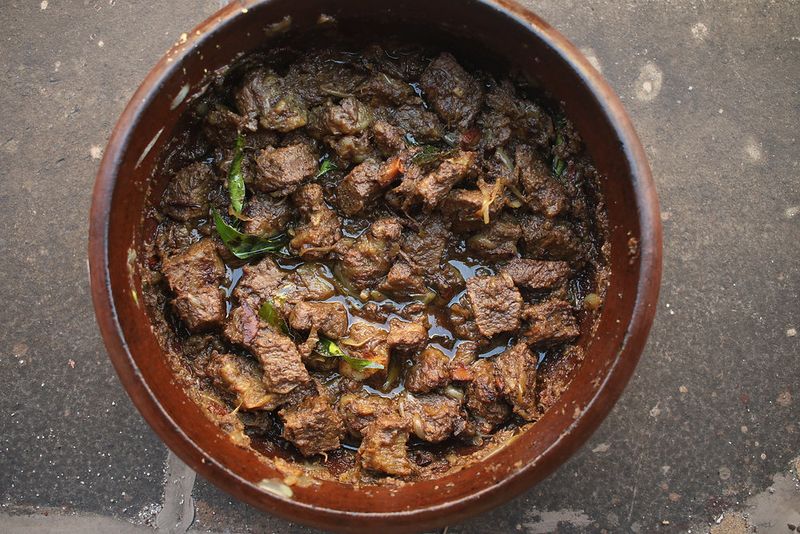
Coastal Kerala’s Christian communities developed this intensely flavored dry beef preparation that showcases how Indian cuisine handles meat with the same spice sophistication as vegetarian dishes. Chunks of beef undergo slow transformation through hours of cooking with coconut slivers, curry leaves, and a potent spice blend dominated by black pepper rather than red chilies – a nod to Kerala’s history as the heart of the ancient spice trade. The distinctive cooking method involves repeatedly reducing the liquid until the meat absorbs all the flavors, then adding a splash of coconut-infused water and reducing again. This patient process results in beef that’s simultaneously tender inside and caramelized outside, with each piece coated in concentrated spice that delivers a slow-building, complex heat. Traditionally served on banana leaves alongside parotta or appam (rice hoppers), this dish represents the multicultural influences that shaped Kerala’s cuisine – indigenous cooking techniques meeting Portuguese-introduced beef preparation methods and Arab spice trading influence.
Leave a comment